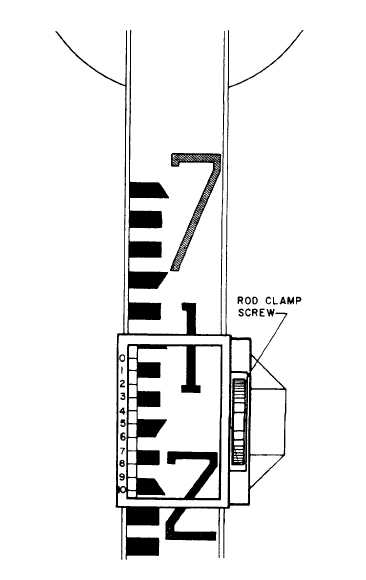There are three situations in which target reading, rather than direct reading, is done on the face of the rod:
When the rod is too far from the level to be read directly through the telescope:
When a reading to the nearest 0.001 foot, rather than to the nearest 0.01 foot, is desired (a vernier on the target or on the back of the rod makes this possible;
When the instrumentman desires to ensure against the possibility of reading the wrong foot (large red letter) designation on the rod.
For target readings up to 7.000 feet, the rod is used fully closed, and the rodman, on signals from the instrumentman, sets the target at the point where its horizontal axis is intercepted by the cross hair, as seen through the telescope. When the target is located, it is clamped in place with the target screw clamp, as shown in figure 5-9. When a reading to only the nearest 0.01 foot is desired, the graduation indicated by the target's horizontal axis is read; in figure 5-9, this reading is 5.84 feet.
If reading to the nearest 0.001 foot is desired, the rodman reads the vernier (small scale running from 0 to 10) on the target. The 0 on the vernier indicates that the reading lies between 5.840 feet and 5.850 feet. To determine how many thousandths of a foot over 5.840 feet, you examine the graduations on the vernier to determine which one is most exactly in line with a graduation (top or bottom of a black dash) on the rod. In figure 5-9, this graduation on the vernier is the 3; therefore, the reading to the nearest 0.001 foot is 5.843 feet.
For target readings of more than 7.000 feet, the procedure is a little different. If you look at the left-hand view of figure 5-8 (showing the back of the rod), you will see that only the back of the upper section is graduated, and that it is graduated downward from 7.000 feet at the top to 13.09 feet at the bottom. You can also see there is a rod vernier fixed to the top of the lower section of the rod. This vernier is read against the graduations on the back of the upper section.
For a target reading of more than 7.000 feet, the rodman first clamps the target at the upper section of the rod. Then, on signals from the instrumentman, the rodman extends the rod upward to the point where the horizontal axis of the target is intercepted by the cross hair. The rodman then clamps the rod, using the rod clamp screw shown in figure 5-13, and reads the vernier on the back of the rod, also shown in that figure. In this case, the 0 on the vernier indicates a certain number of thousandths more than 7.100 feet. Remember, that in this case, you read the rod and the vernier down from the top, not up from the bottom. To determine the thousandths, determine which vernier graduation lines up most exactly with a graduation on the rod. In this case, it is the 7; therefore, the rod reading is 7.107 feet.
Rod Levels
A rod reading is accurate only if the rod is perfectly plumb (vertical) at the time of the reading. If the rod is out of plumb, the reading will be greater than the actual vertical distance between the height of

Figure 5-13. - Philadelphia rod target reading of more than 7.000 ft.
Continue Reading